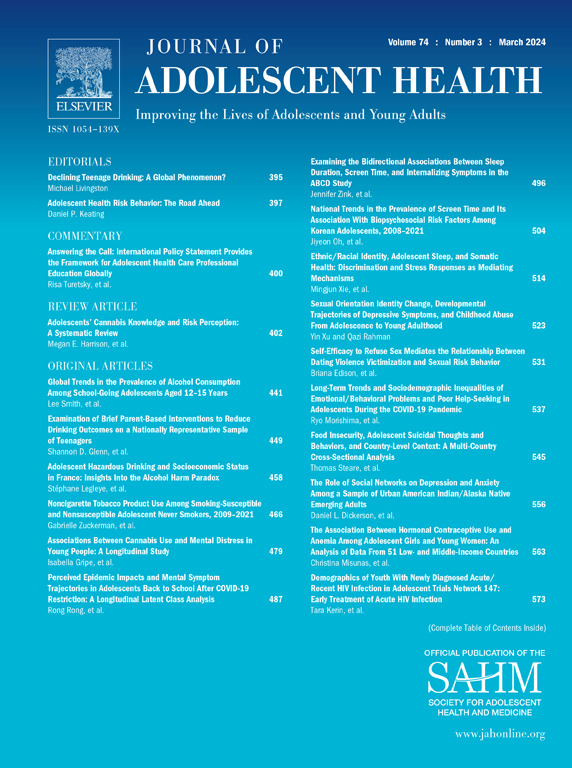青少年时间利用与心脏代谢健康:一项横截面构成分析,探索 24 小时活动行为与心脏代谢健康生物标志物之间的关联。
IF 5.5
2区 医学
Q1 PEDIATRICS
引用次数: 0
摘要
目的:人们已经广泛研究了日常活动行为(如睡眠、久坐时间、站立时间、轻强度身体活动(LIPA)和中高强度身体活动(MVPA))对健康的影响。通常,这些行为都是单独研究的。然而,每天的时间是由以固定的24小时周期进行的活动组成的;因此,花费在每个活动行为上的时间是相互依赖的。孤立地关注一种行为的增加,忽略了在其他行为上花费的时间的变化。本研究旨在通过成分数据分析,探讨青少年运动行为与心脏代谢健康指标之间的关系。方法:研究对象(N = 222;16.3年[0.92],平均值[±标准差];49%男性)提供了身体组成(身高、体重、腰臀比、4点皮肤厚度)、心肺功能(CRF)、握力、血压(BP)、血脂(低密度脂蛋白胆固醇(LDL-C)、高密度脂蛋白胆固醇(HDL-C)、总胆固醇(TC)和甘油三酯)和血糖控制指标。基于设备的活动行为测量是通过activPAL 3微信号获得的。在控制年龄、性别和学校位置的情况下,采用组合线性回归模型检验活动行为与健康指标之间的关系。结果:LIPA(相对于其余行为)与皮褶厚度总和相关(β = -13.9;p < 0.05), CRF (β = 3.9;p < 0.05),舒张压(β = -8.3;P < 0.05)。久坐时间和站立时间与握力较低相关(β = -5.4;p < 0.05)和LDL-C (β = -0.38;P < 0.05)。MVPA与HDL-C相关(β = 0.7;P < 0.05)和甘油三酯(β = -0.1;P < 0.05)。将30分钟的睡眠、久坐时间或站立时间重新分配给LIPA或MVPA与心脏代谢健康指标的显著改善相关。讨论:这是第一个在青少年中应用成分数据分析的研究,该研究包括了身体活动连续体上的所有活动行为。研究结果强化了MVPA对青少年健康的益处,但也提供了证据支持通过减少坐着时间来增加LIPA和站立可以改善肥胖、CRF、舒张压和LDL-C的测量。需要进一步的介入研究来证实目前的发现。本文章由计算机程序翻译,如有差异,请以英文原文为准。
Adolescent Time Use and Cardiometabolic Health: A Cross-Sectional Compositional Analysis to Explore Associations Between 24-Hour Activity Behaviors and Biomarkers of Cardiometabolic Health
Purpose
The health effects of time spent in daily activity behaviors, such as sleep, sedentary time, standing, light-intensity physical activity (LIPA), and moderate-to-vigorous intensity physical activity (MVPA), have been widely examined. Typically, these behaviors have been studied in isolation. However, daily time is composed of activities undertaken in a fixed 24-hour cycle; thus, time spent in each activity behavior is codependent. A focus on increase in one behavior in isolation ignores the consequent changes in time spent in other behaviors. This study aimed to examine the relationship between adolescent activity behaviors and indicators of cardiometabolic health by using compositional data analysis.
Methods
Participants (N = 222; 16.3 years [0.92], mean [±standard deviation]; 49% male) provided measures of body composition (height, weight, waist-to-hip ratio, 4-site skinfold thickness), cardiorespiratory fitness [CRF], grip strength, blood pressure [BP], blood lipids (low-density lipoprotein cholesterol [LDL-C], high-density lipoprotein cholesterol [HDL-C], total cholesterol [TC], and triglycerides) and markers of glucose control. Device-based measures of activity behavior were obtained from the activPAL 3 micro. Compositional linear regression models were used to examine the relationship between activity behaviors and health indicators while controlling for age, sex, and school location.
Results
LIPA (relative to the remaining behaviors) was associated with the sum-of-skinfold thickness (β = −13.9; p < .05), CRF (β = 3.9; p < .05), and diastolic BP (β = −8.3; p < .05). Sedentary time and standing time were associated with lower grip strength (β = −5.4; p < .05) and LDL-C (β = −0.38; p < .05), respectively. MVPA was associated with HDL-C (β = 0.7; p < .05) and triglycerides (β = −0.1; p < .05). Reallocating 30 minutes from sleep, sedentary time, or standing time to LIPA or MVPA was associated with significant improvements in cardiometabolic health indicators.
Discussion
This is the first study to apply compositional data analysis in adolescents that has included all activity behaviors on the physical activity continuum. The findings reinforce the health benefits of MVPA for adolescents but also provide evidence to support that increasing LIPA and standing through decreasing sitting time will improve measures of adiposity, CRF, diastolic BP, and LDL-C. Future interventional research is required to confirm the present findings.
求助全文
通过发布文献求助,成功后即可免费获取论文全文。
去求助
来源期刊

Journal of Adolescent Health
医学-公共卫生、环境卫生与职业卫生
CiteScore
10.40
自引率
3.90%
发文量
526
审稿时长
46 days
期刊介绍:
The Journal of Adolescent Health is a scientific publication dedicated to enhancing the health and well-being of adolescents and young adults. Our Journal covers a broad range of research topics, spanning from the basic biological and behavioral sciences to public health and policy. We welcome a variety of contributions, including original research papers, concise reports, literature reviews, clinical case reports, opinion pieces, and letters to the editor. We encourage professionals from diverse disciplines such as Anthropology, Education, Ethics, Global Health, Health Services Research, Law, Medicine, Mental and Behavioral Health, Nursing, Nutrition, Psychology, Public Health and Policy, Social Work, Sociology, and Youth Development to share their expertise and contribute to our mission of promoting adolescent health. Moreover, we value the voices of young individuals, family and community members, and healthcare professionals, and encourage them to submit poetry, personal narratives, images, and other creative works that provide unique insights into the experiences of adolescents and young adults. By combining scientific peer-reviewed research with creative expressions, our Journal aims to create a comprehensive understanding of the challenges and opportunities in adolescent and young adult health.
 求助内容:
求助内容: 应助结果提醒方式:
应助结果提醒方式:


